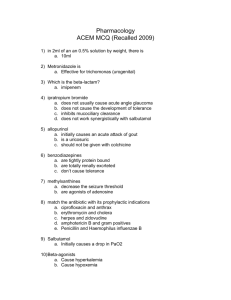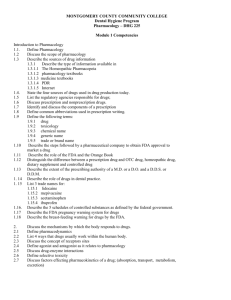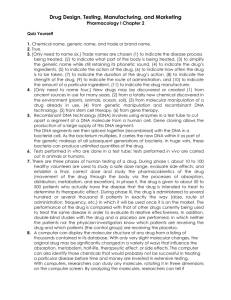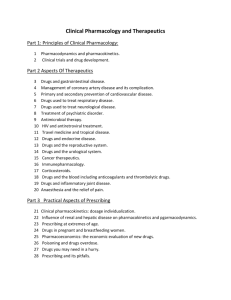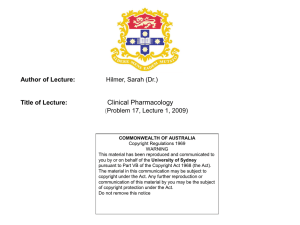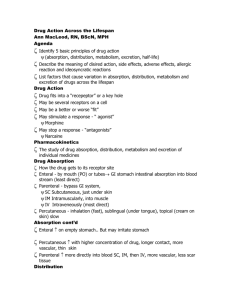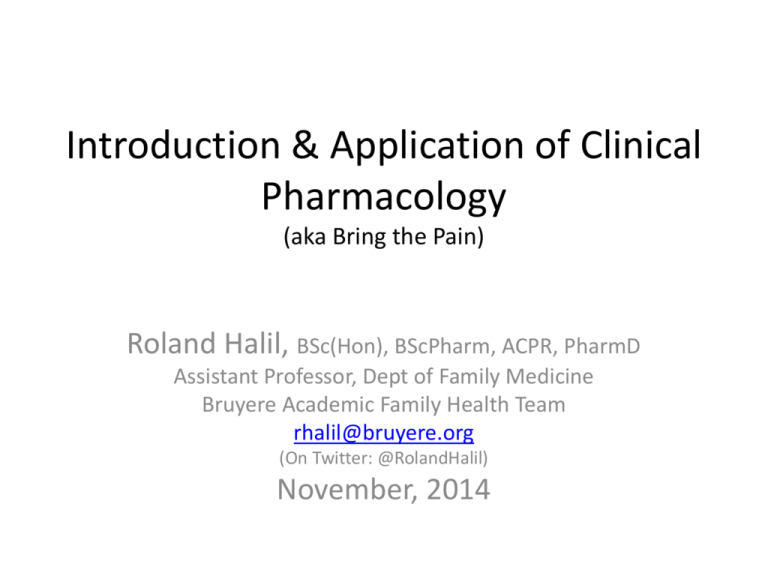
Introduction & Application of Clinical
Pharmacology
(aka Bring the Pain)
Roland Halil, BSc(Hon), BScPharm, ACPR, PharmD
Assistant Professor, Dept of Family Medicine
Bruyere Academic Family Health Team
rhalil@bruyere.org
(On Twitter: @RolandHalil)
November, 2014
Objectives
• Review the basic parameters of pharmacology
including:
1. Mechanism of action
2. Pharmacokinetics (PK)
3. Pharmacodynamics (PD)
• Highlight various parameters that hold clinical
utility in a primary care setting
• Outline a process for incorporating new
pharmacology knowledge to guide therapeutic
choices.
Clinical Utility of Pharmacology
•
•
•
•
•
•
•
Is this an irrational drug combination?
Do I need a loading dose?
How long till this drug reaches steady state?
How do I manage drug interactions?
Will genetics affect my delivery of care?
How long till this drug is out of my system?
How do I manage this overdose?
Pharmacology & Therapeutics
• Therapeutics require a foundation of
pharmacology.
– Provides a mechanistic understanding of why
therapeutics work
– Highlights most of the potential toxicities to your
patients.
– Provides greater comfort in prescribing beyond first
line choices from guidelines
– Avoids the trap of pattern recognition as a basis for
prescribing
Approach to Pharmacology
1. Learn the drug classes and mechanisms of action
in your personal formulary
2. Learn (generally) if drugs are cleared via kidney
or liver
– If hepatically cleared – ?Via P450 enzymes or not?
• If so, use Lexi-Interact to check for drug interactions.
• N.B. There are too many to know without software!
3. Learn (generally) if drugs have a lot of drug
interactions or not
– Think of potential drug interactions via the 1
dynamic and 4 kinetic mechanisms
Approach to Therapeutics
Four Steps of Rational Prescribing
Prioritize:
1. Type of harm
2. Quantity of harm
3. Quality of evidence
4. Time to harm
Prioritize:
1. Type of benefit
2. Quantity of benefit
3. Quality of evidence
4. Time to benefit
1) Efficacy
2) Toxicity
3) Cost & 4) Convenience
(Affects compliance)
Pharmacology
• A science dealing with the fate of drugs in the
body and their biological actions within the
body
Drug
• Any substance that has the effect of altering normal
body functions.
• The alteration can be beneficial or not!
• “Everything is a poison...the dose differentiates a
poison from a remedy.”
– Paracelsus
• Eg. Botulin toxin
• Eg. Oxygen
Pharmacology
Pharmacokinetics
• What the body does to
the drug
Pharmacodynamics
• What the drug does to
the body
Pharmacodynamics
What the drug does to the body
Receptors
1 – lipidsoluble drug
crosses the
membrane
and acts on an
intracellular
receptor
2 – the drug binds
a transmembrane
protein, activating
an enzymatic
activity of its
cytoplasmic
domain
3 – the drug
binds a
transmembrane
receptor bound
to a protein TK,
which it
activates
4 – the drug
binds to, and
directly
regulates the
opening of, an
ion channel
5 – the drug
binds to a
cell-surface
receptor
linked to an
effector
enzyme by a
G protein
Basic & clinical pharmacology [electronic resource] / edited by Bertram G. Katzung, Susan B. Masters, Anthony J. Trevor.
Receptors
• With few exceptions, drugs act on target proteins:
–
–
–
–
Receptors
Enzymes
Carriers
Ion channels.
• Specificity is reciprocal:
– Drugs bind only certain targets
– Targets recognize only certain drugs
• N.B. No drugs are completely specific in their actions.
– Often, increasing the dose will cause it to lose specificity,
affecting other targets, sometimes leading to side effects.
Drug-Receptor Interaction
• Receptor binding is only one step
• Receptor activation must also occur
– Agonists – strongly activate receptors with high
efficacy
– Partial agonists – weakly activate receptors in isolation
• They can also block (antagonize) full agonists by competition
in their presence
– Antagonists – bind, but do not activate receptors
• This blocks agonists from activating receptors
• Reversible (competitive)
or
• Irreversible (non-competititive)
Dose response curve
A
rectangular
hyperbola
on a linear
scale
Dose response curve (log scale)
A sigmoid
curve on a
logarithmic
scale
Competitive Antagonist
(= Reversible)
• Right shift of the
D-R curve.
• Association &
dissociation of
antagonists with
the receptors
occurs quickly
Eg. Beta-agonists and beta-blockers
• A new
equilibrium is
found at a higher
concentration
Non-Competitive Antagonist
(= Irreversible)
• The antagonist
dissociates slowly,
(or not at all), from
the receptors
• Less than maximal
effect is achieved.
• Less common than
reversible type
• Eg. ASA &
platelet COX
enzymes
Therapeutic Drug Monitoring (TDM)
Drug Concentration
Drug excess (side effects)
therapeutic
range
lack of effect
time
On a concentration-time curve it looks sort of like this:
Pharmacodynamics
• Once you understand the molecular dynamics,
you can better apply the physiological
dynamics in practice!
Case example 1
• 75 y.o. female patient presents to your office
with her son in an altered state of consciousness
and PMHx of cognitive impairement.
• Her meds include:
– Amitriptyline 100mg qhs for sleep
– Oxybutynin 5mg qhs for urinary incontinence
– Haloperidol 4mg qd for symptoms of dementia
• She recently started:
– Chlorpheniramine 2mg qd for allergies
Case 1
• Why is her consciousness altered?
– Additive anticholinergic side effects from all her meds
= additive anticholinergic delirium
Pharmacodynamic Drug Interactions
N.B.
• This is the most common type of drug
interaction!
• Additive, synergistic or antagonistic
actions
Case example 2
• 65y.o male patient with pneumonia was given
a Rx for Levofloxacin 500mg once daily for 10
days by his family doctor.
• You notice that his renal function is only
25mL/min.
• Should you give:
– 500mg q48h OR
– 250mg daily ?
Case 2
• Give 500mg q48hours.
• Levofloxacin shows
“concentration-dependant
killing” dynamics.
– The higher the peak serum
concentration, the better
the killing of bacteria
– A 500mg dose ensures the
peak is kept high.
– A q48h frequency ensures it
doesn’t over-accumulate.
24h 48h
Case example 3
• ID: 69 y.o. woman
• CC: muscle cramps, red
urine, fatigue
• HPI: onset over the
past 3 days, recently
started on new drug for
cholesterol (fenofibrate)
• PMHx: MI, CHF, HTN,
DM2, hypothyroidism,
COPD, atrial fibrillation
• Meds:
–
–
–
–
–
–
–
–
–
–
–
–
–
Acetylsalicylic acid
Warfarin
Metoprolol
Amlodipine
Lisinopril
Furosemide
Nitroglycerin
Rosuvastatin
Metformin
Glyburide
Levothyroxine
Salbutamol
Tiatropium
Case 3
• Exemplifies the importance of looking at temporal
correlations.
– With ++ meds, the recent start of her fibrate is a red flag
– Fibrate + statin = additive risk of rhabdomyolysis
• Consider ‘Challenge / Re-challenge’ tests to differentiate
correlations from causations (on/off/on)
– IF the consequences of the trial are small!
• Also exemplifies the risks of Prescribing Cascades
– Unrecognized interactions result in new drugs to fix problems
that daisy-chain into a long lists of meds!
– As many as 20 drugs can be seen over time!
Pharmacodynamics Summary
• On molecular level:
– Drugs bind with receptors with a certain affinity
– Once bound they might activate the receptor with a
certain efficacy
• Maximal effect = full agonist
• Sub-maxmial effect = partial agonist
• No effect = antagonist
• On physiological level:
– Drugs may interact additively, synergistically or
antagonistically each other or with body systems
Pharmacokinetics
What the body does to the drug
Pharmacokinetics
• Pharmacokinetics deals with the ADME of
drugs:
– Absorption
– Distribution
– Metabolism
– Elimination
Pharmacokinetics
Absorption
Drug absorption
and distribution
Rang, H P. et al.Rang and Dale's
Pharmacology
Copyright © 2012,
© 2012, Elsevier
Inc. All rights
reserved.
Pharmacokinetics
Oral Absorption
• Dependent on many factors:
– Physicochemical factors
• i.e. chelation (eg. Divalent cations (eg. Mg2+, Fe3+, Ca2+ etc) plus L-T4)
– Ionized and unionized states
• Molecular pKa of weak acids and bases ~ dependent on pH
• Strong acids and bases ~ poorly absorbed
– Gut motility
• Slower GI usually = slower drug absorption
• (extreme diarrhea can also reduce drug absorption)
– Particle size and formulation
• Eg. 5-ASA and colonic site of action
– Passive vs Active absorption
– Splanchnic blood flow
• Enhanced after a meal (Eg. propranolol, a lipophilic beta-blocker)
– Enterohepatic circulation
Pharmacokinetics
Absorption
Pharmacokinetics – Absorption
“F” = Bioavailability
• Definition:
– “The Fraction of unchanged drug reaching the
systemic circulation following administration by any
route”
• F = 1.0 for IV drugs (100%)
• Mathematically, the area under the blood
concentration-time curve (AUC) measures “F”
– F is estimated as AUCoral /AUCintravenous
• F < 1 due to:
– incomplete extent of absorption &
– first pass elimination.
Pharmacokinetics – Absorption
1st Pass Elimination
• Reduced bioavailability is caused by:
– liver metabolism (major)
– gut metabolism (minor)
– liver excretion into the bile
(minor)
• The effect of first-pass hepatic elimination on
bioavailability is expressed as the Extraction Ratio
(ER)
– Drugs with high extraction ratios will show marked
variations in bioavailability between subjects because
of differences in hepatic function and blood flow.
• Eg. isoniazid, morphine, propranolol, verapamil
Case example
• 75 yo male with 4 days of new onset urinary
frequency and dysuria. Urine is cloudy and
smelly. Patient has had hemodynamic instability
and altered cognition for the past 1.5 days.
• Urine culture & sensitivity shows Pseudomonas
aeruginosa sensitive only to ciprofloxacin.
– Dx: Urinary Tract Infection (UTI), possible urosepsis
– Rx: Cipro - IV or PO? Dose?
Case
• Hemodynamic
instability, delirium,
possible systemic
infection, elderly
patient
– = intravenous (IV) dose
to start
– 400mg IV q12h
• 48h later, patient is
feeling much better,
stable, afebrile.
– Step down to oral (PO)
therapy
– Bioavailability of Cipro?
• Where can I find it?
• Dose = ?
Case
• F = 80%
– 400mg IV is 80% of:
– 500mg PO q12h
• complete 7-14 day course
• Pt returns 2 days later
with the same
symptoms and
hemodynamic
instability.
• Family states he has
been taking his Cipro as
directed every day with
breakfast and supper.
– Breakfast = Lucky
Charms™
– Lunch = steak & eggs,
with salsa piquante
• Milk of Magnesia PRN
– Supper = Grilled Cheese
and yogurt cup
What happened?
Case
Absorption Interaction!
• Chelation of ciprofloxacin by calcium ions
– Breakfast: milk
– Supper: cheese and yogurt
• Any effect from lunchtime Milk of Magnesia?
– No: antibiotic and Mg2+ are not in stomach at the same
time.
– Chelation interaction is one of physical adsorption
• Solution: take on empty stomach or separate
administration from interacting food/drugs by 2 hrs.
PK – Absorption Interactions
Chelation
1. Fluoroquinolones or Tetracyclines plus minerals
[Minerals = calcium (Ca2+) , magnesium (Mg2+) , iron (Fe3+) , aluminum (Al3+)]
[Almost all buffering antacids (i.e. TUMS, Gaviscon, Milk of Magnesia, Rolaids, etc.), as well
as multivitamins, iron tabs etc.]
– Risk of treatment failure!
2. Bisphosphonates plus minerals
– Risk of osteoporotic fracture
3. Phenytoin plus minerals
– Potential loss of seizure control
Separate administration by 2 hours
PK – Absorption Interactions
• Alteration of gastric pH
– Increased pH
• Eg. Long term PPI use
– Reduced absorption of B12, iron & Ca2+ = anemia & osteoporosis
• Eg. Iron / Ketoconazole / Vit B12 absorption is reduced
– Administer with OJ or Coca-cola
• Alteration of GI motility
– Decreased motility
• Eg. Decreased absorption of Levodopa
– Increased metabolism at intestinal brush border
– Increased motility
• Eg. Decreased absorption of Digoxin
PK – Absorption
Summary
• Many factors involved in absorption
• All can affect bioavailability
– None as much as first pass metabolism
– N.B. Check bioavailability whenever changing
route of administration
• (PO to IV or vice versa)
• Clinically important interactions often involve
chelation.
– Separate administration by 2 hours
• Rarely affected by changes in GI motility or gut pH
Pharmacokinetics
Distribution
• To various body stores (reservoirs)
• Volume of distribution (Vd)(in Litres)
– The measure of the apparent space in the body
available to contain the drug
– Vd relates the amount of drug in the body to the
concentration of drug in blood or plasma
– Not a physiological space (Abstract quantity)
•
•
•
•
Fat stores
Plasma proteins (eg. Albumin)
Tissue proteins
Bones etc etc
• Altered in geriatrics
Vd (L) = Amount in body (mg)
.
Concentration in blood (mg/L)
Basic & clinical pharmacology [electronic resource] / edited by Bertram G. Katzung, Susan B. Masters, Anthony J. Trevor.
Basic & clinical pharmacology [electronic resource] / edited by Bertram G. Katzung, Susan B. Masters, Anthony J. Trevor.
Basic & clinical pharmacology [electronic resource] / edited by Bertram G. Katzung, Susan B. Masters, Anthony J. Trevor.
Basic & clinical pharmacology [electronic resource] / edited by Bertram G. Katzung, Susan B. Masters, Anthony J. Trevor.
Oral vs IV Dosing
The effect of slow drug absorption on plasma drug concentration.
Dose Accumulation
Repeated IV Doses
Figure 10.1C
Rang, H P. et al.Rang and Dale's
Pharmacology
Copyright © 2012,
© 2012, Elsevier
Inc. All rights
reserved.
Time to Steady State
Basic & clinical pharmacology [electronic resource] / edited by Bertram G. Katzung, Susan B. Masters, Anthony J. Trevor.
Time to Steady State &
Time to elimination
IV Infusion
1 t ½ = 50%
2 t ½ = 75%
3 t ½ = 87.5%
4 t ½ = 93.75%
5 t ½ = 96.875%
Figure 10.1A
Rang, H P. et al.Rang and Dale's
Pharmacology
Copyright © 2012,
© 2012, Elsevier
Inc. All rights
reserved.
Time to Steady State &
Time to elimination
1 t ½ = 50%
2 t ½ = 75%
3 t ½ = 87.5%
4 t ½ = 93.75%
5 t ½ = 96.875%
Figure 10.2
Rang, H P. et al.Rang and Dale's
Pharmacology
Copyright © 2012,
© 2012, Elsevier
Inc. All rights
reserved.
Loading Dose
DL (mg) = Target Concentration (mg/L) x Vd (L)
• Sometimes needed if the time to steady state
takes too long, due to:
– Long half-life
• Eg. Amiodarone (anti-arrhythmic) – t½ ~ 50 days!
OR
– Risk from sub-therapeutic effect is high
• Eg. Clopidogrel (anti-platelet) – immediately post-stent
How does this relate to missed doses?
Eg. A patient receives a drug every 12 hours.
The drug has a half-life of ~5.7 hour
The patient misses a dose but
remembers half way
through the interval.
Should the patient:
1) Take the next scheduled dose
(forget missed dose)
or …
2) Take the missed dose
immediately and
resume normal dosing
or …
3) Take two doses
at the next scheduled time?
Option 1: Take the next scheduled dose
(forget missed dose)
Curve will
resemble the
accumulation
after 1st or 2nd
dose.
Same
accumulation
up to steady
state
Option 2: Take the missed dose immediately
(in the 6th hour) and resume normal dosing (q12h)
Some extra
accumulation
and then drifts
back to steady
state.
Option 3: Take both doses next time it is due
N.B. More
extra
accumulation
vs option 2
Still drifts
back down to
steady state!
Loading
Dose
• Time to steady state is NOT faster!
– Still 3 to 5 half-lives!
– Without loading dose:
• Serum concentration drifts up to steady state (accumulates)
– With loading dose:
• Serum concentration drifts down to steady state
• Clinical scenario will guide which is needed
Drug Concentration
- Which is more dangerous to the patient?
- Risk of poor outcomes with sub-therapeutic
initial concentration?
OR
- Risk of side effects with supra-therapeutic initial
concentration?
Drug excess (side effects)
therapeutic
range
lack of effect
time
1st Order Kinetics
• Dose accumulation (and decay) is exponential
– “1st order kinetics”
– Almost all meds follow this process
1st order Kinetics
Exponential decay
Linear on log scale
Slope = t½
Figure 10.1 Rang, H P. et al.- Rang and Dale's Pharmacology
Copyright © 2012, © 2012, Elsevier Inc. All rights reserved.
Zero order kinetics
Linear decay (on linear scale)
(velocity but no acceleration!)
Alcohol and Phenytoin
(anti-epileptic) are the
most common examples of
drugs with zero order
elimination.
AKA:
- Enzyme saturation
kinetics
- Non-linear kinetics
- Michaelis-Menten
kinetics
- Capacity-limited kinetics
Figure 10.3 Rang, H P. et al.- Rang and Dale's
Pharmacology . Copyright © 2012, © 2012, Elsevier
Inc. All rights reserved.
1st order & Zero order kinetics
With zero order drugs, “small changes in dose can result in
large changes in serum concentrations.”
Case example
• 70 yo female patient with new, symptomatic
atrial fibrillation, failed electrical cardioversion
and cannot tolerate her palpitations despite
good heart rate control with a beta-blocker.
– Cardiology starts Amiodarone (anti-arrhythmic)
– t½ of Amio ~ 50 days.
– What to do?
Case
• Time to steady state will be 150 - 250 days away!
• Loading dose is needed:
– 200-400mg daily till achieve 10g total
• Then 100-200mg daily thereafter
• (Higher doses result in too many toxicities)
Case example 2
• 70yo male with new myocardial infarction –
underwent stent implantation: will need antiplatelet
therapy to prevent restenosis of the coronary artery
– ASA 81mg plus
– Clopidogrel 75mg daily maintenance dose OR
– Clopidogrel 300mg loading dose?
• After a single, 300 mg loading dose:
– Platelet inhibition of 40% - 50% is observed 2 - 5 hours.
• After repeat dosing of 75mg daily:
– Platelet inhibition of 40% - 50% is observed in 3 - 7 days
Savcic M, et al. Clopidogrel loading dose regimens: kinetic profile of pharmacodynamic response in healthy subjects. Semin Thromb
Hemost. 1999;25 Suppl 2:15-9.
Case example 3
• You are a PGY1 on a general medicine ward. Your
staff physician phones you to start an ACE
inhibitor (Ramipril 5mg daily) for your patient’s
BP and then hangs up. (so rude!)
– You know it could cause acute renal failure and
hyperkalemia and requires monitoring of SCr and K+
– When you do you perform the routine monitoring
blood work?
• In 3 to 5 half-lives! ~ 3-5 days
• In family practice: ~ 1 week
Pharmacokinetics
Distribution – Drug Interactions
• Displacement Reaction
– (from protein binding sites)
– Rarely clinically significant
– Often need:
• Highly bound drug
– (98% bound to 96% bound = 100% increase in free
concentration)
• PLUS, inhibition of metabolism (or elimination) to allow
enough time for these effects before redistribution to a
new steady state.
Pharmacokinetics
Distribution – Drug Interactions
• Eg. Warfarin + SMX/TMP (Septra®)
– Displacement of warfarin off protein binding sites
• (plus inhibition of metabolism
and Vitamin K synthesis by gut flora)
• Eg. Phenytoin + Valproic acid
– Displacement of phenytoin off binding sites
• (plus inhibition of metabolism
and zero order kinetics (enzyme saturation kinetics) of
phenytoin)
Hogan M.J. et al. DNS Aug. 30, 1999 http://www.findarticles.com/p/articles/mi_m3374/is_13_21/ai_55693815/pg_4 Accessed Apr 18/12
PK – Distribution - Summary
• Volume of distribution reminds us that drugs can
concentrate in many body spaces
– N.B. Drugs bound to proteins are not active!
• Repeated dosing will result in accumulation until a
steady state is achieved (1st order kinetics)
– In 3 to 5 half-lives – (same as 1st order elimination)
• This knowledge will help you monitor the efficacy and safety of meds
you prescribe!
• A loading dose will not achieve steady state faster, only
prevent sub-therapeutic concentrations while it is being
achieved
• Few clinically relevant drug interactions here
Pharmacokinetics
Metabolism
• Hepatic
– Also intestinal, plasma, pulmonary etc. (minor)
• Phase I metabolism
– Catabolic
– Oxidation, reduction, hydrolysis reactions
• Render molecules more polar – easier to eliminate
• Eg. Cytochrome P450’s
• Phase II metabolism
– Anabolic – conjugation reactions – (rendering inactive)
• Eg. Glucuronidation, acetylation
• Some conjugated products are excreted via bile, are reactivated in
the intestine and then reabsorbed (‘enterohepatic circulation’).
Clearance
• The measure of the ability of the body to eliminate a
drug
• The factor that predicts the rate of elimination in
relation to the drug concentration
– CL = rate of elimination ÷ concentration
– CLTotal = CLLiver + CLRenal + CLOther
• Affected by:
– physiologic processes
• (eg, maturation of organ function in infants)
– pathologic processes
• (eg, heart failure, renal failure)
• N.B. Also affects volume of distribution, (the measure of the
apparent space in the body available to contain the drug.)
Prodrug
• An inactive precursor chemical that is readily
absorbed and distributed and then converted
to the active drug by biologic processes.
• Eg. Clopidogrel
– Loading dose = 300mg
– Maintenance dose = 75mg daily
– Prodrug to active form
Pharmacogenetics / Pharmacogenomics
PK – Metabolism Interactions
• Metabolism occurs in many places
– Skin, lung, intestine, serum, kidney, liver
– Most metabolism occurs in the liver
• Few interactions with non-oxidative metabolism –
(ubiquitous enzymes)
– Not everything is P450
• P-glycoprotein poorly understood so far
– Genetic variability becoming more important
• Isoniazid, codeine
PK – Metabolism Interactions
• Cytochrome P450 isoforms – so many!
• Family - Subfamily - Genotype (eg. 2-C-19)
(18)
(42)
(60)
– Substrates, inhibitors, & inducers for each isoform!
– 3A4 - most common
PK – Metabolism Interactions
• Inducers:
• Ask: Time to effect?
– ~ 2 weeks to kick in
– ~ 2 weeks to fade out
• Substrates:
– Ask: Consequences of
sub-therapeutic doses?
Flockhart D.A. P450 Table www.medicine.iupui.edu/flockhart/table.htm Accessed Sept 19/04.
PK – Metabolism Interactions
• Inducers of 3A4:
–
–
–
–
–
–
–
–
• Substrates of 3A4:
Rifampin / Rifabutin
Efavirenz / Nevirapine
Glucocorticoids
Phenytoin
Carbamazepine
Barbiturates
St. John's Wort
Pioglitazone (Actos™)
etc
–
–
–
–
–
–
–
–
Clarithro / Erythromycin
Alpraz / Diaz / Midazolam
CSA / Tacrolimus
Indinavir / Nelfinavir
Ritonavir / Saquinavir
Amlodipine / Felodipine
Nifedipine / Verap / Dilt
Atorva / Simvastatin
Estrogen
Carbamazepine
etc
Flockhart D.A. P450 Table www.medicine.iupui.edu/flockhart/table.htm Accessed Sept 19/04.
PK – Metabolism Interactions
Clinical Scenarios
• 50 y.o. male - PMHx of
HTN, MI x3, COPD on:
– Ramipril 10mg daily
– HCTZ 25mg qAM
– Amlodipine 10mg daily
– BP control borderline/high
– COPD exacerbation
• Rx: PREDNISONE 25mg qAM
for 7 days
• 50 y.o. female – PMHx of
DM2, renal transplant on:
–
–
–
–
Ramipril 10mg daily
Amlodipine 10mg daily
Tacrolimus 10mg BID
Cyclosporine 15mg BID
– Endo Rx: ACTOS 30mg qd
– N.D.: St John’s Wort i qd
• Issues?
• Issues?
» NO!
» YES!
PK – Metabolism Interactions
Pearl
• Inducers of 1A2:
• Substrates of 1A2:
– Nicotine
– Caffeine
– Smoking cessation…
– Sweaty, anxious,
nauseous, sleepless…
– Nicotine withdrawal?
– No! Caffeine overdose!
Flockhart D.A. P450 Table www.medicine.iupui.edu/flockhart/table.htm Accessed Sept 19/04.
PK – Metabolism Interactions
• Inhibitors:
• Ask: Time to effect?
– Immediate effect
– Hours/days to fade
• Substrates:
– Ask: Consequences of
supra-therapeutic doses?
Flockhart D.A. P450 Table www.medicine.iupui.edu/flockhart/table.htm Accessed Sept 19/04.
PK – Metabolism Interactions
• Inhibitors of 3A4:
–
–
–
–
–
–
Clarithro / Erythro
Ciprofloxacin
Fluco / Itra / Ketoconazole
Grapefruit juice
Amiodarone
Indinavir / Nelfinavir
Ritonavir /Saquinavir
Delaviridine
– Verapamil / Diltiazem
– Cimetidine
• Substrates of 3A4:
– Alpraz / Diaz / Midazolam
– Cyclosporine / Tacrolimus
– Amlodipine / Felodipine
Nifedipine / Verap / Dilt
– Atorva / Simvastatin
– Clarithro / Erythromycin
– Indinavir / Nelfinavir
Ritonavir / Saquinavir
– Estrogen
– Carbamazepine
Flockhart D.A. P450 Table www.medicine.iupui.edu/flockhart/table.htm Accessed Sept 19/04.
etc
PK – Metabolism Interactions
Clinical Scenarios
• 60 y.o. female – PMHx of
HTN on:
– Nifedipine XL 60mg qd
– BP: 105/60
– Enjoys a fresh grapefruit
when in season.
• 60 y.o. male – PMHx of
NSTEMI, CHF on:
–
–
–
–
Atorvastatin 80mg qd
Ramipril 10mg qd
ASA 81mg qd
Bisoprolol 5mg qd
– New onset Afib – Cardio Rx:
Amiodarone 200mg daily
• Issues?
• Issues?
» No!
» Yes, two!
PK – Metabolism Interactions
Pearl
• Inhibitor of 2C19:
– Omeprazole
• Substrates of 2C19:
– Clopidogrel
• ?All PPI’s
– Time to effect is
immediate
– Lack of metabolism from
pro-drug to active form
– Sub-therapeutic effect!
Flockhart D.A. P450 Table www.medicine.iupui.edu/flockhart/table.htm Accessed Sept 19/04.
PK – Metabolism Interactions
Summary
• Inducers
– Remember: time to effect ~
2 weeks
• Longer treatments will
result in more significant
interactions
• Harder to see the
temporal correlation
– Lower doses of affected
substrate need to be
clinically relevant
• Inhibitors
– Remember: time to effect
is immediate
• Shorter treatments will
result in more significant
interactions
• N.B. Drugs with long halflives will take longer to
show their effect!
– Higher doses of affected
substrate need to be
clinically relevant
PK – Metabolism - Summary
• Usually hepatic – very complex
– Phase I & II
• Affects bioavailability (F)
– F affected by Clearance, which is affected by blood flow
• Many, many potential drug interactions
– P450 3A4 most common
– Both inducers & inhibitors of substrate metabolism are
possible
• Timeline to effect is most important!
Pharmacokinetics
Elimination
• Hepatic or Renal
– (Rarely pulmonary for anaesthetic gases)
– (Rarely via milk or other secretions)
• Usually a logarithmic process
– (exponential decay)
• Elimination Rate Constant: ke
• Half-Life: t½
– Determined by clearance (CL) and volume of
distribution (VD)
1st order Kinetics
Exponential decay
Linear on log scale
Slope = t½
Figure 10.1 Rang, H P. et al.- Rang and Dale's Pharmacology
Copyright © 2012, © 2012, Elsevier Inc. All rights reserved.
Elimination of drugs by the kidney
• Most drugs, unless highly bound to plasma
protein, cross the glomerular filter freely.
• Many drugs, especially weak acids and weak
bases, are actively secreted into the renal tubule
and thus more rapidly excreted.
• Lipid-soluble drugs are passively reabsorbed by
diffusion across the tubule, so are not efficiently
excreted in the urine.
• Because of pH partition, weak acids are more rapidly
excreted in alkaline urine, and vice versa.
Rang, H P. et al.- Rang and Dale's Pharmacology
Copyright © 2012, © 2012, Elsevier Inc. All rights
reserved.
PK – Excretion Interactions
• Rarely significant, but…
– Enterohepatic circulation:
• Bile acid sequestrants + Warfarin or L-T4 or Estrogen
– Alteration in urine pH
• Ion trapping
– Eg. Management of ASA overdose with bicarb
– Eg. Methamphetamine overdose with Vit C / NH4Cl
– Competition for tubular transporters
• Anion: Probenecid + beta-lactams (osteomyelitis)
• Cation: Itraconazole /cimetidine + digoxin / quinidine
Case example
• 55 year old male patient is highly distraught
because his citalopram (SSRI antidepressant)
caused him terrible side effects and he is
changing to a new anti-depressant and wants to
know when the citalopram will be out of his
system.
• You reassure him that the offending substance
will be out of his system in:
– Half life (t½) ~ 35 hours
– 3 - 5 half-lives = 105 – 175hrs = 4 - 7 days
Summary
Pharmacology & Therapeutics
• Therapeutics require a foundation of
pharmacology.
– Provides a mechanistic understanding of why
therapeutics work
– Highlights most of the potential toxicities to your
patients.
– Provides greater comfort in prescribing beyond first
line choices from guidelines
– Avoids the trap of pattern recognition as a basis for
prescribing
Summary
Approach to Pharmacology
1. Learn the drug classes and mechanisms of action
in your personal formulary
2. Learn (generally) if drugs are cleared via kidney
or liver
– If hepatically cleared – ?Via P450 enzymes or not?
• If so, use Lexi-Interact to check for drug interactions.
• N.B. There are too many to know without software!
3. Learn (generally) if drugs have a lot of drug
interactions or not
– Think of potential drug interactions via the 1
dynamic and 4 kinetic mechanisms
Approach to Therapeutics
Four Steps of Rational Prescribing
Prioritize:
1. Type of harm
2. Quantity of harm
3. Quality of evidence
4. Time to harm
Prioritize:
1. Type of benefit
2. Quantity of benefit
3. Quality of evidence
4. Time to benefit
1) Efficacy
2) Toxicity
3) Cost & 4) Convenience
(Affects compliance)
Questions?
Pharmacology
• Pharmacokinetics
– A
• 1st pass, F, pKa
• Eg. Drug interactions, chelation, pH,
– D
• Vd, SS, Ld, Md
• Eg. Drug interactions: warfarin septra, PHE,
• Eg. Time to ss – 3-5 t ½’s
– M
• Prodrug, CL, phase I & II, pharmacogenetics, substrates, inhibitors, inducers
• Eg. Drug interactions P450
– E
• Half-life, ke, 1st order, zero order
• Eg. Ion trapping in OD
• Eg. Time to be out of the system 3-5 t ½ ‘s
• Pharmacodynamics
– Dose response curves, rec theory, agonist, partial agonists, reversible and
irreversible antagonists
• Eg. Asa irrev inh of COX in platelets
• Eg. Drug interactions – additive, synergistic, antagonistic effects


